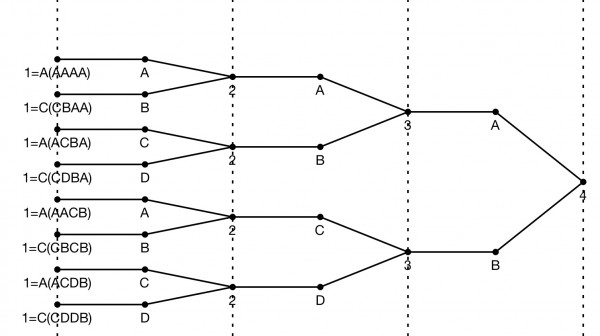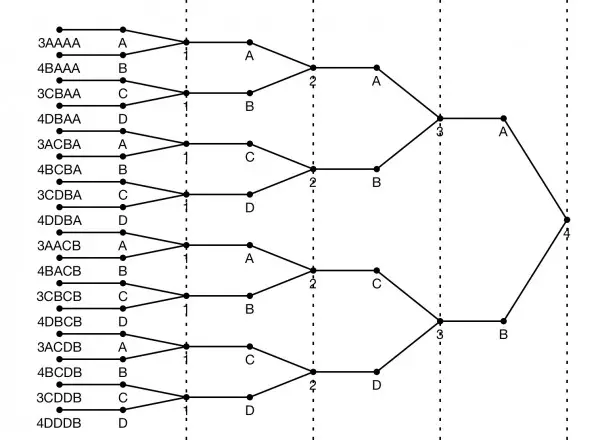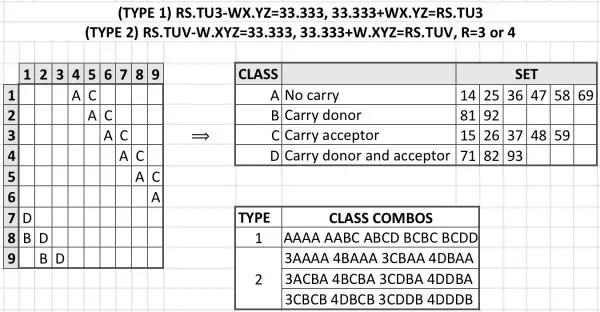Each number node in Figures 1 and 2 represents a column of two digits in the addition (or subtraction), so 1-4 represents the adjacent columns 1 to 4 in the arithmetic, either the first 4 columns or the last 4 columns for Type 1 or 2 respectively.
Figure 1:

Figure 2:

Figure 3 :

Using letters to represent digits 1-9, there are two possible ways to do the arithmetic to get the difference 33.333:
Type 1: RS.TU3-WX.YZ=33.333, which can also be written:
RS.TU3=33.333+WX.YZ.
Type 2: RS.TUV-W.XYZ=33.333, which can also be written:
RS.TUV=33.333+W.XYZ.
It is easier to solve the problem in addition form rather than subtraction.
When adding two digits the sum may be less than 10, so there is no carryover.
If the sum is greater than 10, there is a carryover of 1. This sum is a carryover donor.
Also, the sum of two digits may need to include a carryover of 1 from the next column of figures (when there is one), and, another carryover may result from the sum. Therefore there are 4 classes of sums, designated by the letters A, B, C or D, as shown in the table in Figure 3. For example, 2+3=5, which is a Class A sum since no carryovers are involved. All cells containing A relate digit sums that similarly involve no carryover.
Cells containing B show digit sums generating carryover (donors), for example, 8+3=11, relating 8 and 1.
Cells containing C show digit sums including a carryover (acceptors) from the next column, for example 2+3+1 (carryover)=6, so 2 and 6 are related by Class C.
And cells containing D show digit sums including a carryover from the next column and generating a carryover themselves, for example, 8+3+1=12, so 8 and 2 are related by Class D.
So a sum donating a carryover must be adjacent to a sum accepting a carryover.
This explains what’s going on in the trees in Figures 1 and 2. Figure 1 deals with Type 1 arithmetic while Figure 2 deals with Type 2 arithmetic. These trees show all the possible outcomes of the arithmetic in terms of classes.
In Type 1 arithmetic, the last digit of the 5-digit number must be 3, while in Type 2 arithmetic the first digit (represented by the letter R) is either 3 or 4.
Bear in mind that all digit assignments to the letters are unique so if 3 has been allocated a position no other letter can be assigned a value of 3. Similarly, for 4.
The “leaves” of the trees form groups I call combos, which are unique combinations of classes. Taking each combo in turn and considering the sets of pairs of digits forming a class it’s now possible to search for a set of digits from 1-9 fitting a combo. The combo is eliminated if there are no valid digits.
For example, the combo containing AAAA is not possible because each A requires a unique pair of digits from the set (see the class table in Figure 3), and Type 1 eliminates pairs containing 3 because 3 has already been allocated the last digit position in the 5-digit number. Type 2 eliminates pairs containing 3 or 4 depending on whether the lead digit is 3 or 4. So the set is reduced to { 14 25 47 58 69 } or { 25 36 58 69 } and neither set allows us to select 4 pairs containing unique digits. The best we can do is 3 pairs, for example, 14, 25, 69; 25, 47, 69; 14, 58, 69; 47, 58, 69.
If we find a combo with a valid set of pairs, we have found a solution to the problem.
We arrive at: 41.268-7.935=33.333 as one solution. Also, 41.286-7.953=33.333.